5 - Host mortality and parasitoid impact
Published online by Cambridge University Press: 04 May 2010
Summary
Introduction
With a few exceptions involving tachinids (Edelsten, 1933; DeVries, 1984; English–Loeb, Karban & Brody, 1990), parasitoids of immature holometabolous insects invariably kill their hosts by direct parasitism or host feeding. This produces an obvious and universally recognized potential for parasitoid assemblages to cause significant levels of mortality to host populations. In a recent compilation of published life tables, H. V. Cornell & B. A. Hawkins (unpublished data) tabulated the three most important identified factors causing generational mortality for 123 species of holometabolous herbivores and found that parasitoids were listed more than any other factors, representing 89 of the pooled total of 289 (30.8%). Also, the practice of introducing parasitoids for the biological control of insect pests provides evidence that they can significantly reduce host densities, and, although not well documented in most cases, parasitoids are capable of causing sufficient host mortality to reduce host densities by one or more orders of magnitude (Embree, 1974; Beddington, Free & Lawton, 1978). On the other hand, other herbivores appear virtually immune to biological control by parasitoids (Clausen, 1978), and species are known that, at least locally, suffer minimal or no parasitoid–induced mortality (see for example, Milne, 1963; Clausen, Clancy & Chock, 1965; Wilson, 1968; Ahmad, 1974).
Despite the potential importance of parasitoids to the densities of their hosts, documenting their impact is a time–consuming task, and even when done properly, the evidence is often equivocal (Price, 1987).
- Type
- Chapter
- Information
- Pattern and Process in Host-Parasitoid Interactions , pp. 111 - 131Publisher: Cambridge University PressPrint publication year: 1994



